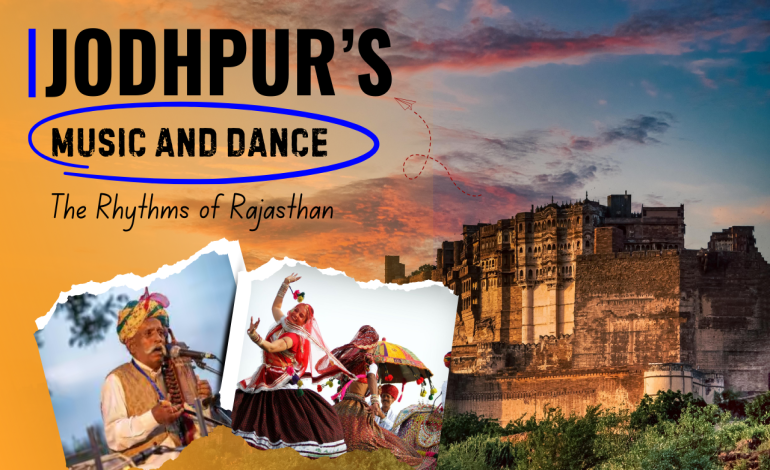
Jodhpur’s Music and Dance: The Rhythms of Rajasthan
I. Introduction
Jodhpur, also referred to as the blue city due to its bright blue houses, is a city where culture and history live. Located at the periphery of the Thar Desert, it's famous not only for its strong forts and palaces but also for its friendly people and authentic traditions. Amongst the numerous colors of Jodhpur's heritage, dance and music have a special place. These forms of art are not just entertainment're a lifestyle. The beats of Jodhpur reflect the character of the desert and the tales of its soulful inhabitants, Jodhpur culture.
II. Historical and Cultural Context
The dance and music of Jodhpur are deeply rooted in the history of the Marwar-Jodhpur event. They originated as a means of expressing everyday life—rain songs, festival dances, and tale-carrying melodies. The royal courts of Jodhpur gradually became a major source of encouragement for these forms of art, with local musicians invited to perform during their courts and festivities. But even outside of the palaces, it was the common people who sustained the culture. From generation to generation, music and dance were transmitted orally, taught within families, exchanged in villages, and staged at festivals. It's this collective community ethos that has served to keep the traditions alive even today.
III. Folk Music of Jodhpur
- Key Instruments:
Folk music in Jodhpur is as steady as the heartbeat of the desert—soulful and full of life. It's performed on traditional instruments like the Ravanhatta and Kamaicha, whose haunting melodies bring it to life, and rhythm-makers such as the Morchang, Khartal, and Dholak. Each of these tells a story, often passed down through generations.
- Popular Music Styles:
The songs themselves are numerous. Maand is semi-classical music that is always elegant, used in royal courts, and sung as such. Panihari songs are sung by women and talk about fetching water, love, and ordinary life in simple, tender songs. Bhajans and ballads talk of devotion and courage and keep alive the legend of Rajasthan.
- Famous Musical Communities:
Most of this music stays alive through the Manganiyar and Langa communities—glimpses of generations of ear-and-heart musicians. The desert terrain molds their songs as well, with phrases replete with yearning, resilience, and revelry. It's music that holds the optimism and the difficulties of Marwar life together.
IV. Traditional Dance Forms
- Ghoomar:
Jodhpur dance is not simply movement; it's an art of telling stories, conveying emotions, and expressing life. Ghoomar is the most popular dance, originating in the royal courts of Rajasthan. Danced by women wearing flowing gowns, the dance is all about twirling elegantly and taking gentle steps. Ghoomar is now a splash at weddings and festivals, adored for its poise and charm.
- Kalbeliya:
And then there's the dramatic Kalbeliya dance, which is danced by the Kalbeliya, or snake-charmer, caste. Its rapid, fluid movements and sweeping gestures make it seem to dance like a snake. It's not only entrancing—it's also been deemed a valuable item of world heritage by UNESCO.
- Terah Taali:
The other distinctive style is Terah Taali, where the dancers attach 13 small cymbals (taalis) to their bodies and strike them in unison as they dance. It's usually performed as an offering to the deity and requires phenomenal skill and coordination.
V. Festivals and Performances
Marwar Festival
In Jodhpur, festivals are a riot of colors, music, dance, and tradition. The Marwar Festival is one of the most loved festivals in the city, which is all about celebrating the city's rich folk culture. Locals and tourists join hands to relish soulful songs, lively dances, and colorful performances that relive the history of Marwar.
Rajasthan International Folk Festival
The other big event is the Rajasthan International Folk Festival (RIFF), which takes place at the stunning Mehrangarh Fort. This special festival combines traditional Rajasthani music with international sounds, creating enchanting performances on clear nights under the stars.
These festivals do more than entertain—they preserve local arts by providing a platform for talented folk performers and encouraging younger generations to follow in their footsteps.
VI. Contemporary Influence and Fusion
Rajasthani dance and music have gained a foothold on international stages, touching the hearts of people far removed from India. Traditional musicians of Jodhpur are today teaming up with global artists, fusing folk music with jazz, electronic, and world music to produce novel, thrilling performances.
Digital media such as YouTube and social media have also thrown up new opportunities, which have helped folk artists win audiences across the world. Cultural tourism in Rajasthan, on the other hand, highlights such art forms, which enable tourists to witness their magic. This lovely blend keeps tradition alive and provides it with a contemporary voice.
VII. Preservation and Future Outlook
Jodhpur's dance and music culture are increasingly challenged by modernization, migration, and eroding traditional ways of living. However, initiatives by cultural institutions and government agencies are working to preserve these art forms. Patronage through festivals, workshops, and grants has worked as a difference-maker. Local patronage, tourism, and incorporating folk arts in schools are also important in ensuring that these rich traditions continue to survive for generations to come.
VIII. Conclusion
Jodhpur's dance and music are not performances but living heritage, carrying the essence of Rajasthan. From the royal courts to rural social occasions, these beats have resounded over the centuries. Keeping them alive is a matter of pride and cultural obligation. As a traveler, a music enthusiast, or just an inquirer, having an experience of Jodhpur's lively sounds and movement is an immersion in the heart of Indian heritage.





